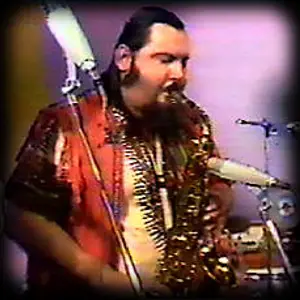GRAHAM BOND
 Graham Bond is one of the long-forgotten pioneers of the British Blues Boom of the early 60s that gave the world The Rolling Stones, Cream and hundreds of bands that incorporated the ‘Blues scale’ and ‘Blues sensibilities’ into mainstream music. Graham’s lack of hit records, his involvement with heavy drugs and The Occult, and ongoing bouts of mental instability led to a tragic early death, but for a time, The Graham Bond Organisation was on the cutting edge of world-changing musical events.
Graham Bond is one of the long-forgotten pioneers of the British Blues Boom of the early 60s that gave the world The Rolling Stones, Cream and hundreds of bands that incorporated the ‘Blues scale’ and ‘Blues sensibilities’ into mainstream music. Graham’s lack of hit records, his involvement with heavy drugs and The Occult, and ongoing bouts of mental instability led to a tragic early death, but for a time, The Graham Bond Organisation was on the cutting edge of world-changing musical events.
A live version of ‘Person to Person’ from Kooks Kleek Club;
Jack and Ginger left to join Eric Clapton in Cream in 1966, and John began pursuing the devotional music that came to fruition with The Manavishnu Orchestra, so Graham recruited drummer Jon Hiseman. When that band broke up the following year, Jon and Dick formed Colloseum and featured Graham’s song ‘Walking in the Park’ on their debut album. Graham took refuge in drugs and began exhibiting bi-polar symptoms, but a spell in The States yielded session work with Dr. John and on Harvey Mandel‘s debut solo album. Returning to England, Graham became obsessed with The Occult, believing himself to be the son of the notorious Satanist and “the wickedest man in the world” Aleister Crowley. He formed a band Holy Magick to record a couple of strange albums, and then toured with Ginger Baker’s Airforce playing alto, also working with The Jack Bruce Band before teaming up with Cream’s lyricist Pete Brown to record the album ‘Two Heads are Better Than One’. In 1973, Graham joined The John Dummer Band, a long-time Blues club favourite, and a record they made laid mysteriously unreleased for 35 years before appearing as ‘The Lost 1973 Album’ in 2008. Seeking to lead his own band again, Graham formed Magus, but could not get a record deal. Disillusionment, drugs and manic-depression all played some part in Graham’s suicide in May 1974, at the age of 36.